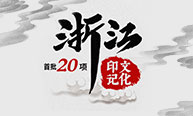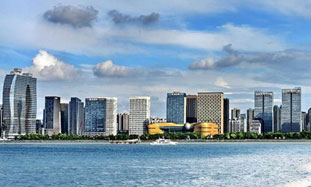The dying craft of dyeing cloth
These patterns are then transferred onto white cotton cloth by brushing a dye-resistant paste made with lime and grounded soy bean over the template. It takes about three days for this paste to dry, following which the cloth undergoes the dyeing process.
Indigo dye is extracted from the woad plant, also sometimes known as Asp of Jerusalem, by grinding and fermenting its leaves. The dye is then poured into a large caldron where the cloth is immersed a number of times until it turns indigo. Following this, workers extend the cloth and scratch off the dye-resistant paste, leaving behind the white motifs underneath.
The last step of the process is the washing of the cloth to remove any remnant particles and hanging it out to dry on poles.
In 2006, this traditional craft was listed as a national intangible heritage. Two years later, Zhou was named as one of the inheritors of this craft.
Though such textiles are no longer as popular as before, Zhou's workshop still sells about 2 million yuan ($303,000) worth of it every year, but most of his clients today are souvenir stalls and clothing boutiques catering to tourists.
"People used to consider these sort of clothes very special. Today, such textiles are more for people who appreciate old culture," said the 66-year-old.
When asked why he has not packed up the business to pursue something more lucrative, Zhou said that he has a responsibility to teach what he knows to the next generation and ensure this traditional craft does not go extinct.
He revealed that he has plans to build a museum to showcase this traditional handicraft and teach people how to create their own indigo cloth.
"Allowing people to experience the process of making this textile is an essential element in the preservation of this craft. It helps them to appreciate the effort that goes into making such products," he said.
"Today, there are many machine-made alternatives in the market that use synthetic dye, but they cannot be called lan yin hua bu. This product we have here is all-natural. There's hardly anything else like it." he added.
xingyi@chinadaily.com.cn

Zhou Jiming's Tongxiang Indigo Print Making is one of the oldest workshops for blue floral print cloth in Tongxiang, Zhejiang province. Photos by Gao Erqiang / China Daily
(China Daily 12/03/2017 page10)

 Print
Print Mail
Mail
 20 Cultural Symbols
20 Cultural Symbols Why Zhejiang
Why Zhejiang Experiencing high-tech products at WIC
Experiencing high-tech products at WIC Zhejiang Release
Zhejiang Release Zhejiang News
Zhejiang News